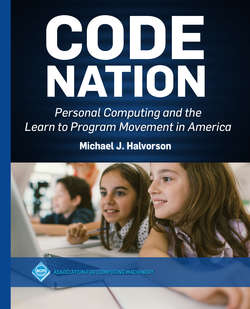Читать книгу Code Nation - Michael J. Halvorson - Страница 9
На сайте Литреса книга снята с продажи.
1How Important is Programming?
Оглавление“To understand computers is to know about programming. The world is divided… into people who have written a program and people who have not.”
Nelson, Ted Ted Nelson, Computer Lib/Dream Machines (1974)
How important is Programming it for you to learn to program a computer?
Since the introduction of the first Digital electronic computers digital electronic computers in the 1940s, people have answered this question in surprisingly different ways.
During the first wave of commercial computing—in the 1950s and 1960s, when large and expensive mainframe computers filled entire rooms—the standard advice was that only a limited number of specialists would be needed to program computers using simple input devices like switches, punched cards, and paper tape. Even during the so-called “Golden age” of corporate computing “golden age” of corporate computing in America—the mid- to late 1960s—it was still unclear how many programming technicians would be needed to support the rapid computerization of the nation’s business, military, and commercial operations. For a while, some experts thought that well-designed computer systems might eventually program themselves, requiring only a handful of attentive managers to keep an eye on the machines.
By the late 1970s and early 1980s, however, the rapid emergence of Personal computers (PCs) PCs.Personal computers personal computers (PCs), and continuing shortages of computer professionals, shifted popular thinking on the issue. When consumers began to adopt low-priced PCs like the Apple II (1977), the IBM PC (1981), and the Commodore 64 (1982) by the millions, it seemed obvious that ground-breaking changes were afoot. The “PC Revolution” opened up new frontiers, employed tens of thousands of people, and (according to some enthusiasts) demanded new approaches to computer literacy. As Ted Nelson, a prolific inventor and computing advocate wrote, “You can and must understand computers NOW!” On learning to program computers, Nelson energetically compared programming to another American obsession—driving an automobile. “If you’ve never written a program, it’s like never having driven a car,” Nelson instructed. “You may get the general idea, but you may have little clear sense of the options, dangers, constraints, possibilities, difficulties, limitations, and complications.”1
Figure 1.1ProgrammingAmerican school children experiment with computer programmingAmerican school children experiment with computer programming using teletype machines (1970s). (Courtesy of the Computer History Museum)
Ted Nelson was not alone. By the late 1970s, scores of programming advocates recommended that people of all ages learn to code as a way of understanding what the world’s most intriguing devices were capable of. Computer programming—a process of formulating a problem for the computer to solve, writing instructions in a given computer language, loading instructions into the computer’s memory, running the program, and correcting errors—had emerged as a major late-night pastime and (for some) a promising profession. In response to the mandate of Nelson and others, a surge of interest in programming developed, and the number of people who could write at least elementary programs grew from several thousand in the early 1950s into millions by the early 1980s. (See Figure 1.1.) This sea change in computational literacy encouraged the widespread adoption of computers, boosted the global economy, and shaped the contours of the modern information age.
